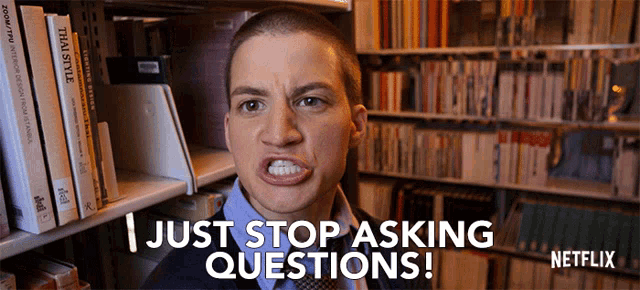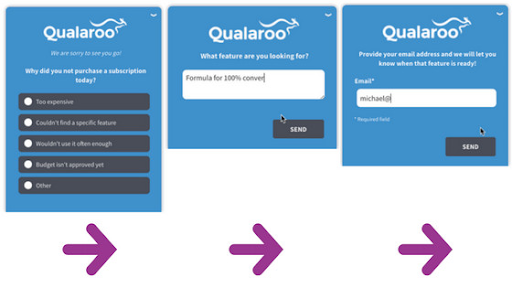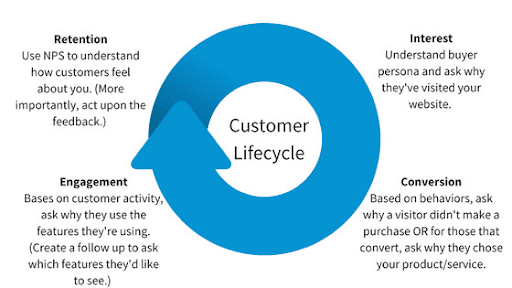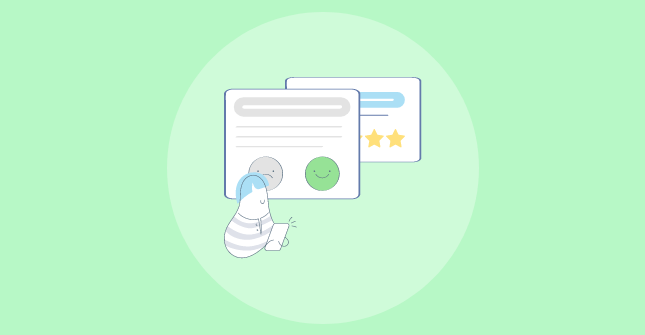
Do you have an estimate of how many surveys you’ve received in the past week? The past month? The past year? When you open your inbox, isn’t it flooded with requests to share your “valuable opinion/thoughts”? For example, whenever you make a purchase, you probably received an email with a survey that asked something like:
How did you like ___(what you bought)___?
How would you rate your shopping experience on a scale of ___ to ___?
Please tell us what you thought of __(seller’s brand)___
If you are running a business, you can see that these types of questions are too generic. Your customers expect to receive them. But customers have no incentive to respond to them because they’re the usual questions they’ve seen a hundred times: not personalized or relatable, and consequently, they don’t respond.
You’re wasting time, effort, and money on what could – and should – have been an insightful engagement.
In this blog, you’ll learn how to avoid this and get on the right track to delight your survey takers while getting the right feedback from them. Analyze this feedback to get actionable insights about customers!
What is Survey Fatigue?
You know that feeling you get when you’ve had too much of something like candy, or ice cream, or hot dogs?
How do you deal with it when you are offered more of that same thing?
What can you do to get a break from it?
Consider the same situation, but about the surveys you send.
That is what survey fatigue feels like.
Survey fatigue is a sign that people are bored, uninterested, or outright annoyed by feedback surveys.
It is a relatively new phenomenon, mainly because of the innumerable surveys people come across every day. Think about it – languishing in their email inboxes, sent to them as text messages, popping up on websites they visit, intruding on them as they scroll through social media — surveys are everywhere!
Yet, response rates are plummeting. With lesser customer feedback, companies have to take risks about whether the product or service they are offering for sale will resonate with their target market.
So what is the solution to survey fatigue? Do you stop sending surveys altogether?

Don’t get us wrong – surveys are great, but with a qualifier: they’re only great when they delight people.
To that end, let’s figure out how to delight the people whose feedback you seek.
We will begin by uncovering the causes of survey fatigue, then discussing its types and how to overcome this challenge with actionable and insightful feedback to avoid its negative impact.
What Causes Survey Fatigue?
One of the most common causes of survey response fatigue is repetitive questions. A Stanford University study on survey fatigue concluded that “The number of times a respondent has taken [a] survey has an adverse effect on the quality of answers they provide.”
The same study also highlighted the length of the survey as a contributing factor for questionnaire fatigue because “the extent of respondents’ survey fatigue at late stages in the survey, resulting in underreporting of activities, is significant both statistically and substantively.”
Simply put, seeing similar surveys peeves people. Plus, they don’t like to answer too many questions.
So let’s dig into the various types of participant fatigue that can result from these (and more) factors.
What Are the Different Types of Survey Fatigue?
Two major types of respondent fatigue are classified according to the phase of the survey in which the respondent considers quitting the questionnaire/survey:
- Over-surveying – When respondents don’t even begin the survey because they have faced (or been forced to respond to) too many surveys and feedback methods to care about them
- Over-questioning – When respondents begin the survey but get tired due to too many questions, or unclear questions, or personal questions, and abandon without completion
Knowing the types of survey fatigue is good and all, but have you tried reducing survey fatigue?

To tackle over-surveyed respondents, you need to come up with fresh surveys. Whether it’s changing the visual look and feel through custom designing or using newer/different methods of survey delivery like in-app NudgesTM for Android & iOS, you need to hold their attention and encourage them to share.
Dealing with over-questioned respondents, on the other hand, requires better question development. A few factors that affect how easily your intended responders get tired of your surveys are the types of questions you use, preset answers for users to select from, and the option to give free-form text answers.
So how do you jump these hurdles that stand in the path of your business’s growth? Here’s a step-by-step framework to redefine the way you may have been conducting surveys till now!
How To Overcome Survey Fatigue: Step-by-Step
For starters, speed through this brief checklist with your existing survey before you get on with the larger task:
Upgrading it to be a perfect survey that asks the right question at the right time to the right person.
- Respond to your survey like your target audience would
- Eliminate each & every unnecessary question ruthlessly
- Mark all junctions where conditional logic can be applied
- Consider adding an open-ended feedback question at the end
Optimized your currently running survey? Time to upgrade it into a great survey that doesn’t cause fatigue.
Let’s have a look at the right steps.
Step 1: Make Your Questionnaire
- Make an exhaustive list of empathetic questions: Get them all in there because that was the easy part.
- Keep questions clear and concise: If it takes people too much time to think or reason, it will strain them. For this reason:
- Avoid open-ended, fill-in-the-blank questions
- Use yes/no and multiple-choice questions
- Don’t use a rating matrix: A list of items that need scoring on a scale of 1 to 10 sounds boring to any survey taker. Tracking it is hard as well.
- Use branching and skip logic: Use this to present the most relevant questions to people. Let them skip whatever’s not applicable to them.
- Delete complicated, indirect, or offensive questions. Bring in unbiased people to expand your viewpoint and judge the survey.
- Cross out every question whose answer does not enrich your knowledge in exactly the way you need to improve your business.
Read More – Survey vs Questionnaire: Compare the Differences
Step 2: Set the Right Length and Time for Your Survey
Is your survey short and sweet? Fill in the responses, time it, then invite your peers and time them, too.
If you feel it is not stretching out the intended respondents’ minds unnecessarily, you’ve struck gold.
Tip: Consider adding a visual progress bar at the top to encourage respondents to finish the survey.
The length of the survey and the time taken to complete it are quite important factors that directly affect the quality of the customer feedback – making them both short. Distill the questionnaire until you have only the most concise, relevant, and empathetic questions. Keep the survey length as short as possible. Make sure respondents don’t feel like they are investing too much time, or your abandonment rate will rise.
Focus on gathering insights, not just answers.
So what is the recommended length for a survey?
Five minutes – that’s it; if you are looking at the time taken to complete. Research shows that you absolutely need to keep it under 20 minutes.
What is the ideal number of questions for a survey?
Ten – if there are multiple topics to address, create short surveys for each topic.
Bonus tips on how to write the best survey questions
- Use simpler language and avoid jargon.
- Use shorter questions instead of compound ones.
- Don’t use questions that are too personal or threatening (if you still feel the need, then place them at the end, so that survey taker are not shocked right off the bat).
- Use a customer feedback tool that offers readymade survey templates designed for specific use cases.
Step 3: Fine-Tune Your Survey
- Make sure you are maintaining a consistent scale (e.g., Likert, numerical/alphabetic grades, stars, etc.)
- Apply conditional logic, skip logic, question branching to reduce the chances of survey fatigue further.
- Carefully consider the pros and cons of having an open text field generic feedback question at the end.
- Test different frequencies of sending your surveys to identify the frequency that nets the most feedback.
- Use advanced targeting techniques to make sure that your surveys are reaching only the most relevant targets.
The last two points are crucial. Here’s why:
Repeatedly insisting upon customers to provide feedback hurts you twofold:
- Customer attrition: They may leave you for your competition
- Irrelevant feedback: The quality of their feedback drops
That is why you must continuously test and identify the most promising frequency of sending out surveys.
Sending surveys to people who are not the right people to give you insight into your target market is useless. Instead, build customer personas that reflect your target market. Using these personas enables you to get the maximum from your surveys by targeting the right people to get highly relevant feedback.
Here’s a great example targeting a user that has visited your pricing page twice and has not made a purchase yet.

You have the power and knowledge to generate unique engagements tailored to who your users are or what they’re doing.
Bonus Tips to Make The Survey Experience Better
- Mention how much time it will take people to complete the survey.
- Give a solid and transparent reason why the survey taker should participate. This can include the outcome or result in you expect from it. Ensure that the outcome you specify matches the questions you ask.
- If your survey results helped you make a decision (an outcome that you specified in the beginning), then communicate it to the survey takers to make them feel a part of the change.
Need more information?
Check out our extensive and insightful Marketer’s Guide To Surveying Users
Step 4: Test Your Survey(s) & Launch!
Are you in the enviable position of having more than one version of your survey? Time for A/B testing.
Even with one great survey, you may find aspects that could be improved once it is out there. Fix them.
Remember – A survey may lose its novelty and efficiency over time. Be prepared to keep updating!
Bonus Step: Create a Continuous Feedback Loop
Closing the customer feedback loop is a good practice to remain customer-centric. Asking customers regularly (but without annoying them) yields immediate benefits for business, provided you extract actionable insights from their responses to your customer feedback surveys and implement those insights. A few of the benefits derived from being customer-centric:
- Decreased customer churn rate
- Increased customer lifetime value (LTV)
- Impressed customers = positive word-of-mouth
The feedback loop is of special importance if your position vis-a-vis your competition depends on staying up to date with customer preferences. Here’s how you can ask the right questions to the right customers unobtrusively and delightfully, as well as a comprehensive bank of questions you can ask customers.

Bonus Related Read: How To Improve Survey Response Rate
People are faced with hundreds, if not thousands, of decisions every day. Try not to waste their valuable time (and, by extension, your own precious time) by asking them irrelevant or extra survey questions.
How Survey Fatigue Impacts Your Business Negatively
Ask yourself – why are you doing a survey?
To get answers?
To gather data?
To explore what else you might be doing to make your customers more happy and satisfied than they have ever been before?
Whatever your reason for carrying out surveys, if the responses aren’t useful to your purpose, it’s a failure. And one of the biggest challenges in gathering relevant customer feedback is survey fatigue.
Survey fatigue can impact your business quite severely – and these are not positive impacts.
Some of the possible negative impacts that may stem from survey fatigue (and its underlying causes):
- Bring down your response rate
- Reduce the value of responses
- Drop customer retention rate
- Give you useless customer data
- Increase customer attrition rate
- Make your brand look unprofessional
And these are just the direct, obvious factors. In the larger picture, survey fatigue causes intangible losses that can eventually come back to impact businesses’ bottom lines negatively if left unchecked.
Qualaroo uncovers the ‘why’ – not just about survey fatigue, but behind customers’ actions
Qualaroo lets you engage your customers on a more intimate level to get truly actionable insights! Asking contextual and relevant questions throughout the customer journey as opposed to just the beginning or end lets you access a wealth of knowledge about your customer’s decision-making process.
You will learn why customers are making certain decisions and, hence, predict their desires better. Your surveys should ask relatable questions that get you true collect customer feedback to understand them better, not run-of-the-mill template-based generic ones that may cause survey fatigue and impact growth.
Watch: How To Collect Customer Feedback
Ask contextual questions at the moment with Qualaroo NudgesTM to eliminate survey fatigue. Most importantly, if your survey completion rates are dropping alarmingly, take immediate action now!
Want insights that improve experience & conversions?
Capture customer feedback to improve customer experience & grow conversions.





